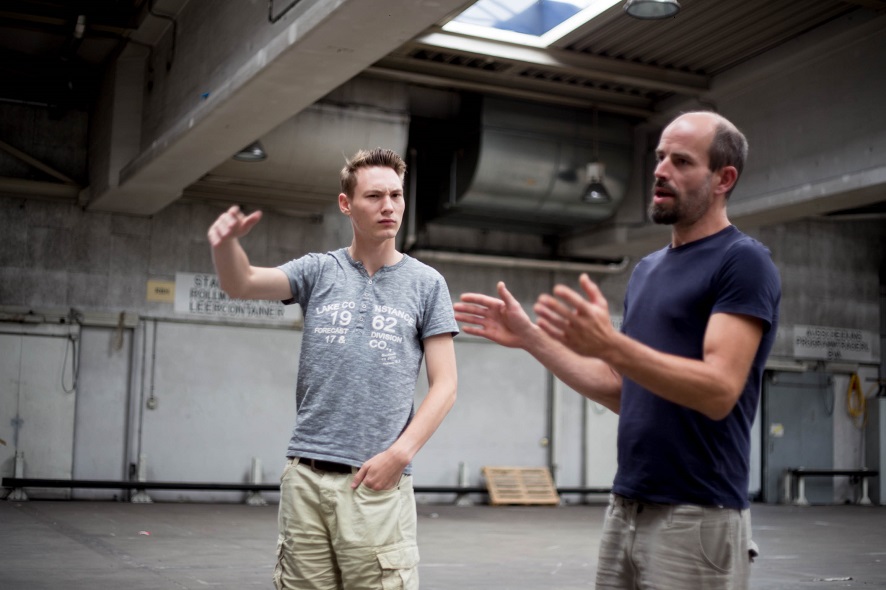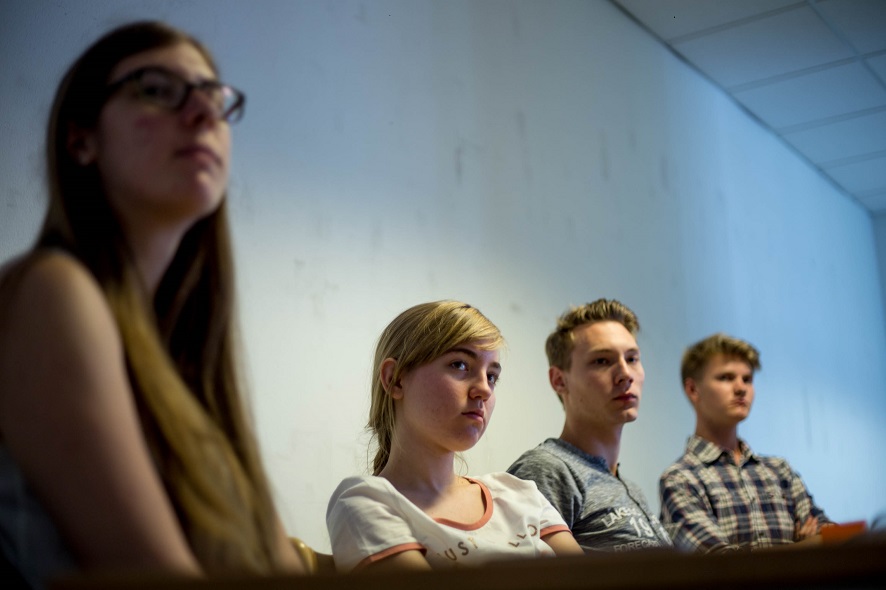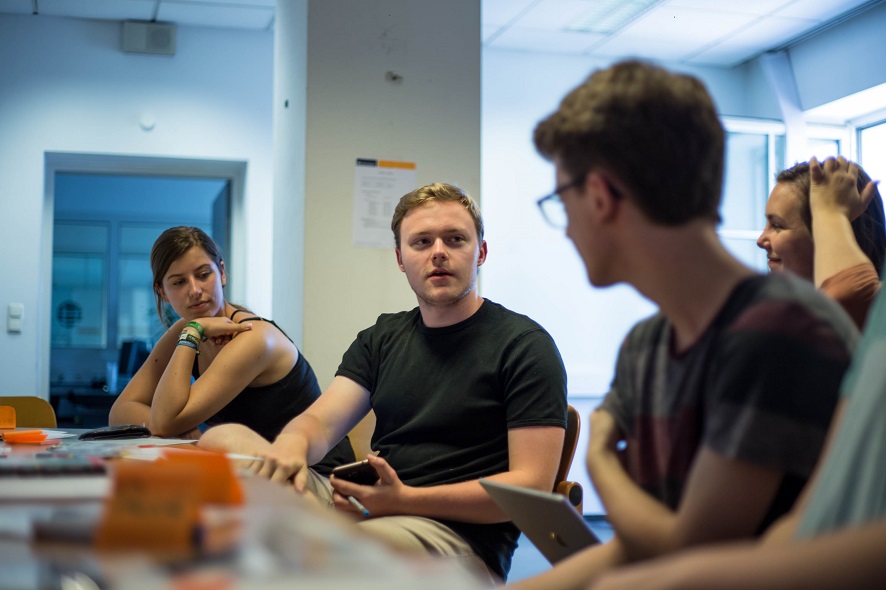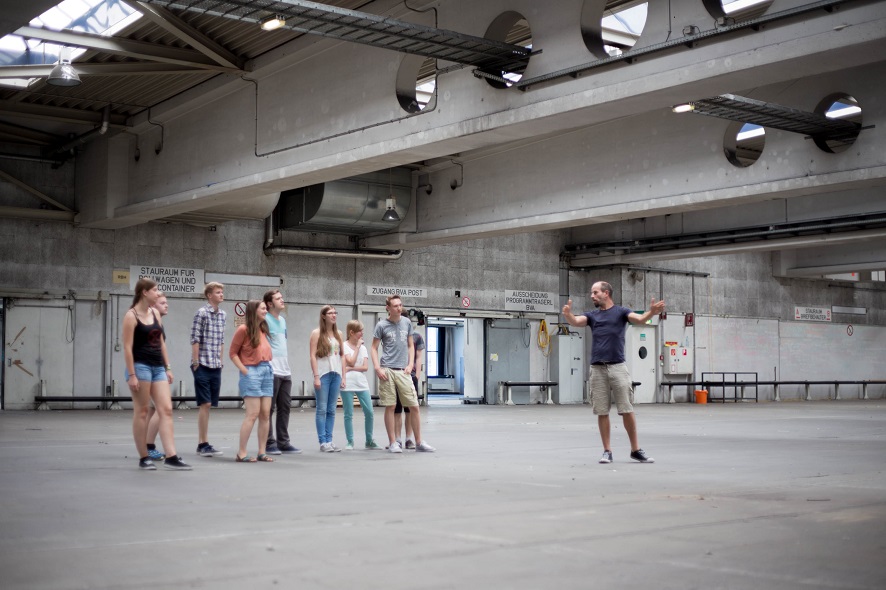It’s Thursday of the last week of school before summer break. Most pupils are still in class. The exception: kids singled out for recognition in the Prix Ars Electronica’s u19 category. They’ve convened in POSTCITY Linz to work with Marion Friedl and Hans Christian Merten of Ars Electronica’s staff on a concept for the exhibition of their prizewinning works.
The Prix Ars Electronica’s u19 category annually honors outstanding achievement in media art by kids and young people. The prizewinning works then go on display at the Ars Electronica Festival—this year, September 7-11, as part of the Create Your World Festival. This is the second year in a row that the youngsters themselves are also doing what adults previously did—configuring the exhibition that will be featuring their projects.
We stopped by for a preview of what awaits festivalgoers at the 2017 u19 exhibition. Marion Friedl, Hans-Christian Merten and four creative youngsters—Manuel Achhorner, Florian Buger, Sonja Futterknecht and David Holy—filled us in.

Credit: Vanessa Graf
Marion, you’re leading this year’s workshop for the young Prix prizewinners. What’s the reason for this session?
Marion Friedl: The workshop we’re holding again this year is an answer to a question: How can we better integrate the u19 prizewinners into the entire process? We simply wanted them to discover how to present a project so that it can be conveyed most effectively. Last year, we realized that this functions best when, after the winners are announced, we invite them all to a session at which they present their work to each other. What are these 16 projects, actually, and who are the people behind them? How did these projects come about? And this brought out some common ground.
This year, we want to go one step further—that is, not just for them to give us ideas on how we should exhibit their work, but to really, actively participate in the entire process. After all, we do this with the other artists too. So, we’re giving youngsters the chance to get involved and thus discover a thing or two about their own project and how it ultimately comes across to exhibition visitors.

Credit: Vanessa Graf
Can you already give us some details about how this year’s exhibition is going to look?
Marion Friedl: In any case, there’ll be a lot that visitors can try out themselves. We want the u19 exhibition to be highly prominent within the Create Your World area, so it’s going to be relatively spacious. At the moment, I could say more about individual projects. As far as the interplay among them is concerned, it’s still open. There are already initial attempts to identify their impact on one another—for example, is it possible to link up one game to another? But we’re still in the imagineering phase; implementation comes next.
The music videoThaiboxbrüderschaft is one of the projects that has received a Honorary Mention in the u19 category this year.
What trends do you notice among the projects?
Marion Friedl: The jury singled out for a wide variety of works for honors—recognizing both the media used and the content itself. In 2016, there were many projects dealing with migration, a topic that hardly comes up at all this time around. There were many dystopias this year—guilt-ridden scenarios, test situations, horror films. Two of the prizewinners deal with school systems and learning formats. In fact, there was generally a strong focus on school, in which this institution gets called into question somewhat, made fun of a little, also laid bare for all to see.
There’s a lot of tinkering once again, lots of work with Arduino, DIY stuff involving soldering and programming. A striking feature is that the animators are getting younger and younger. So, one upshot of technology becoming more user-friendly is that kids can get started with it earlier.

Credit: Vanessa Graf
Manuel Achhorner is a Prix Ars Electronica u19 prizewinner. He and partner Josef Adelsberger—both Digital Business majors at Kitzbühel Commercial Academy—received an Honorary Mention for their game “You Are President.”
Manuel, can you briefly explain your project to us?
Manuel Achhorner: In “You Are President,” the player is a country’s head of government and faces lots of problems and decisions that can be answered with either “Yes, we’re doing that” or “No, we’re not doing it.” And you see the projected consequences of these actions expressed in terms of ratings. When your rating falls to zero, you lose—you get impeached, you die, you lose your job. And when you succeed in reaching 20, you get reelected or you can retire.
How important is it to you to have a say in the exhibition design?
Manuel Achhorner: Very much so, because I want to see how I present myself, my school and my project. I want to see how this plays out, and also how the others present their projects.
How should your game ideally be displayed at the Ars Electronica Festival?
Manuel Achhorner: My ideal conception is that the player sits at a really beautiful, classically designed, sold wood desk like in the Oval Office. And then with two flags behind you; in front, the directions depicted as an Executive Order; and, of course, a computer screen. It ought to look as if the player really is president.

Credit: Vanessa Graf
Florian Buger, Sonja Futterknecht and David Holy—together with Mario Kerndler and Maria Raser—are also being honored for a game by the Prix Ars Electronica. Their 2-D action adventure LARES garnered an Award of Distinction for these students at Vienna’s Spengergasse High School.
Florian, Sonja and David—tell us what LARES is all about.
David Holy: You play household deity. LARES—the word comes from Roman mythology, from lares familiares, the spirits that protect families. You play one of them in the form of a little girl’s doll. When the girl has a nightmare, you enter her dream to protect her, to liberate her from the nightmare. In doing it, you fight against shadowy monsters.
What do you have to say about being a part of the exhibition design process?
David: Pretty cool, actually. We didn’t know how much freedom we’d have, but it turns out to be a lot. To a certain degree, we can determine exactly what arrangement we’d like to have.
Florian: Our idea was pretty basic—two computers, keyboard, mouse. Now, we’ve found out that we can do a lot more, that it can be much more elaborate, more appealing. We think it’s really great that we can present our game in such an excellent way.
So how do you imagine exhibiting your game?
Sonja: At the moment, we’re toying with the idea of printing out some of the game figures as life-size cardboard cutouts and thus sort of recreating elements of the game world.
Florian: You can amuse yourself in the game’s world of play. And the larger the installation space is, the cooler it would be.
David: We also want to have an area where people can see how we produced the game, what tools we used. We want to show that actually anyone can create a game of their own. Especially now with the internet, you can find everything you need. It’s not as hard to get started as it used to be.
Lisa Buttinger won this year’s Golden Nica with her project “nonvisual-art”.
The exhibition of the works by u19 Prix prizewinners is part of the CREATE YOUR WORLD festival for young people, which is being staged for the 7th time this year in conjunction with the Ars Electronica Festival. Hans Christian Merten, the director of CREATE YOUR WORLD, talked to us about how the u19 projects fit into this “festival within a festival.”
Hans Christian, how does the u19 Prix exhibition dovetail with the rest of CREATE YOUR WORLD?
Hans Christian Merten: This year’s Create Your World theme is “Perspectives.” We want to bring out diversified points of view. This agenda, manifested to a great extent in analog form, will be a part of this year’s festivals. But the centerpiece, of course, is the u19 Exhibition in which we showcase perspectives of young people across the age group spectrum. And we cordially invite grown-ups to draw a bit of inspiration from this.
In connection with the Perspectives theme, I particularly want to accentuate our collaboration with Joseph Herscher, an artist from New York who’s the director of this year’s youth encounter project. This is a workshop attended by 20 youngsters from all over Europe who come together during the festival to build or design something. In prior years, the participants, for example, developed a computer game, produced a piece of music, and shot their own film. This year, it’s “The Unintelligent Machine.” The point is to enable youngsters to express themselves on various topics like artificial intelligence, the future of technology and environmental issues, and these expressions are then represented in an analog machine, which finally gets built in cooperation with the artist. So, it’s totally open as to how this is going to look in the end. In any case, it’ll be a machine in which everyday objects influence each other and trigger mechanical reactions.
The consideration behind this is deceleration. Here, the participants are working with mechanical elements that, in sum, do indeed lead to a result that also answers the question that was originally posed, but the participants spend a tremendous amount of time dealing with stuff that is seemingly senseless. After all, this could be accomplished much more quickly! But this approach leads to a sort of relaxation and you even goes through phases in which you might even forget what the question actually was because you’re concentrating so intensely on the process itself. This leads to a point at which the question of the end effect can be seen from another perspective.

Manuel Achhorner (born 1999) is majoring in Digital Business at Kitzbühel Commercial Academy. He and his project partner, Josef Adelsberger (born 2000), are very interested in politics, though their respective Weltanschauungen are highly dissimilar. This shared interest and their computer programming skills gave rise to the idea for their game “You Are President.”

Florian Buger (born 1997), Sonja Futterknecht (born 1998) and David Holy (born 1997) are seniors at Spengergasse High School in Vienna, where they’re majoring in Game Design. They created their 2-D adventure game in conjunction with their graduation project.
The u19 – CREATE YOUR WORLD festival will be held during the Ars Electronica Festival, September 7-11, 2017 in POSTCITY Linz. For details, follow us on Facebook, Twitter, Instagram et al., subscribe to our newsletter, and check out our website at https://ars.electronica.art/ai/en/.
